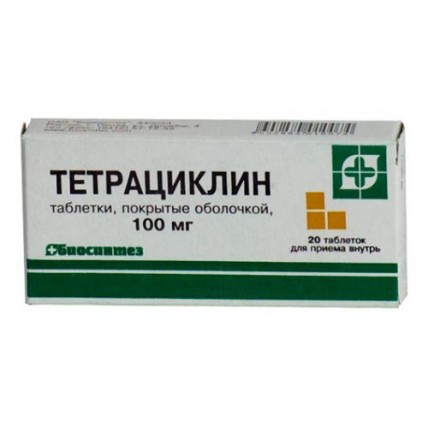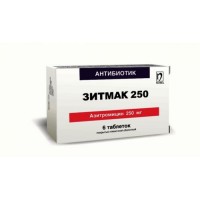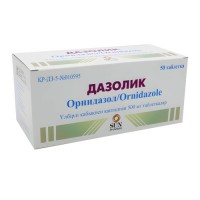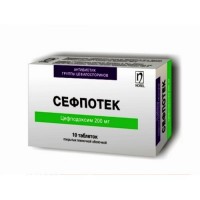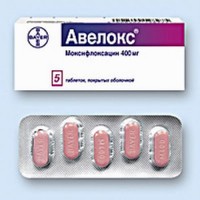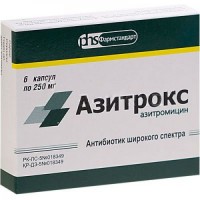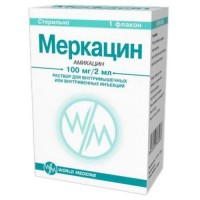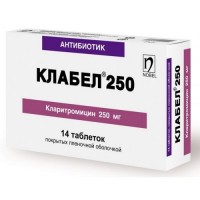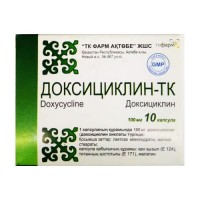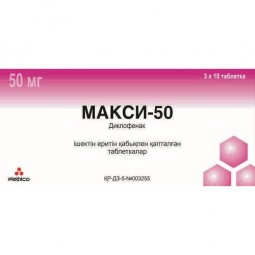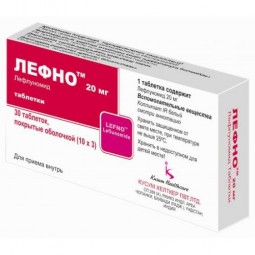Tetracycline 100 mg coated (20 tablets)
- $4.00
Out Of Stock
Sku:
1fccacb3065c
Brand:
Biosintez (Russia)
The instruction for medical use
of medicine
tetracycline
the Trade name
Tetracycline
the International unlicensed
name Tetracycline Dosage Form
of the Tablet, coated, 100 mg
Structure
One tablet contains
active agent: tetracycline a hydrochloride in terms of active agent – 100 mg,
excipients: sucrose (sugar), calcium stearate, magnesium hydrosilicate (talc), gelatin, potato starch,
cover excipients: gipromelloza, lactoses monohydrate (sugar milk), polysorbate-80 (twin-80), dye azoruby (acid red 2 C) E122.
The description
of the Tablet, film coated, red color, round shape, with a biconvex surface. On cross section two layers are visible: external – red color, internal – yellow color.
Pharmacotherapeutic group
Antibacterial drugs for system use. Tetracyclines
the ATX J01AA07 Code
the Pharmacological
Pharmacokinetics Absorption properties – 75 - 77%, at meal decrease, communication with proteins of plasma – 55 - 65%. Time of achievement of the maximum concentration at oral administration – 2 - 3 h (for achievement of therapeutic concentration 2 - 3 days can be required). During the subsequent 8 h the concentration gradually decreases. The maximum concentration - 1.5-3.5 mg/l (for achievement of medical effect there is enough concentration of 1 mg/l).
In an organism it is distributed unevenly: in the maximum concentration contains in a liver, kidneys, lungs and in bodies with well developed reticuloendothelial system - a spleen, lymph nodes. Concentration in bile is 5 - 10 times higher, than in blood serum. In fabrics thyroid and a prostate tetracycline content same, as in plasma, in pleural, ascitic liquid, saliva, milk of the feeding women – 60 - 100% of concentration in plasma. In large numbers collects in a bone tissue, fabrics of tumors, in dentine and enamel of milk teeth. Badly gets through a blood-brain barrier. At an intact meninx in cerebrospinal fluid it is not defined or found in insignificant quantity (5 - 10% of concentration in plasma). At patients with diseases of the central nervous system, especially at inflammatory processes in brain covers, concentration in cerebrospinal fluid makes 8 - 36% of concentration in plasma. Gets through a placental barrier and into breast milk. Distribution volume - 1.3-1.6 l/kg.
It is slightly metabolized in a liver. Elimination half-life – 6 - 11 h, at an anury – 57 - 108 h. In urine it is found in high concentration in 2 h after reception and remains during 6 - 12 h, for the first 12 h the kidneys remove about 10 - 20% of a dose. In smaller quantities (5 - 10% of the general dose) it is removed with bile in intestines where there is a partial return absorption that promotes long circulation of active agent in an organism (enterohepatic circulation). Removal through intestines – 20 - 50%. At a hemodialysis is removed slowly.
A pharmacodynamics
the Bacteriostatic antibiotic from group of tetracyclines. Breaks formation of a complex between acceptor RNA and a ribosome that leads to suppression of synthesis of protein. It is active concerning gram-positive microorganisms - Staphylococcus spp. (including Staphylococcus aureus, including the strains producing penicillinase), Streptococcus spp. (some strains, including Streptococcus pneumoniae), Listeria monocytogenes, Bacillus anthracis, Clostridium spp., Actinomyces spp., Propionibacterium acnes, Bacillus fusiformis,
- gram-negative microorganisms - Haemophilus influenzae, Haemophilus ducreyi, Bordetella pertussis, Escherichia coli, Enterobacter spp. (including Enterobacter aerogenes), Klebsiella spp., Shigella spp., Yersinia pestis, Bartonella bacilliformis, Vibrio cholerae, Vibrio fetus, Rickettsia prawazekii, Rickettsia reckettsii, Rickettsia akari, Borrelia Vinceni, Borrelia recurrentis, Borrelia burgdorferi, Brucella spp. (in a combination with streptomycin), Calymmatobacterium granulomatis, Francisella tularensis, Treponema pallidum, Treponema pertenue,
- at contraindications to prescribing of penicillin - Clostridium spp., Neisseria gonorrhoeae, Actinomyces spp.,
- is active concerning Chlamydia trachomatis, Chlamydia psittaci, Entamoeba histolytica,
- microorganisms are resistant to tetracycline: Pseudomonas aeruginosa, Proteus spp., Serratia spp., majority of strains of Bacteroides spp. and mushrooms, viruses, beta and hemolytic streptococci of group A (including 44% of strains of Streptococcus pyogenes and 74% of strains of Streptococcus faecalis).
Indications
the Infectious and inflammatory diseases caused by microorganisms, sensitive to tetracycline:
- the pneumonia and respiratory infections caused by Mycoplasma pneumoniae, Haemophilus influenzae and Klebsiella spp.
- bacterial infections of urinogenital bodies: clamidiosis, uncomplicated gonorrhea, an inguinal granuloma, a venereal lymphogranuloma, syphilis, shankroid
- infections of skin and soft tissues
- an ulcer and necrotic gingivostomatitis
- actinomycosis
- an intestinal amebiasis in complex therapy,
- a brucellosis
- a bartonellosis
- cholera, plague, anthrax
- listeriosis
- an ornithosis
- a vesicular rickettsial disease, spotty fever of the Rocky Mountains, a sapropyra, a typhinia
- a tularemia
- a frambeziya
- botulism
- food toxicoinfection
- dysentery
- a vibriosis
- Lyme's disease
the Route of administration and doses
Inside, washing down with a large amount of liquid.
The adult - on 0.3-0.5 g each 6 hours (4 times a day) or on 0.5-1 g each 12 hours (2 times a day). The maximum daily dose - 4 g. Course of treatment
of 5-10 days.
A brucellosis – on 0.5 g each 6 hours within 3 weeks, along with intramuscular administration of streptomycin in a dose of 1 g each 12 hours within 1 week and 1 times a day within 2 weeks.
Uncomplicated gonorrhea - an initial single dose – 1.5 g, then on 0.5 g each 6 hours within 4 days (total dose of 9 g).
Syphilis – on 0.5 g each 6 hours within 15 days (early syphilis) or 30 days (late syphilis).
The uncomplicated urethral, endocervical and rectal infections caused by Chlamydia trachomatis - on 0.5 g each 6 hours within not less than 7 days.
Listeriosis – for 0.2 - 0.3 each 6 hours within 7 – 10 days.
Actinomycosis – on 3 g a day in the first 10 days, then on 0.5 g each 6 hours during the last 18 days.
An inguinal granuloma, a venereal lymphogranuloma – on 0.5 g each 6 hours within 3 – 4 weeks.
An ornithosis – on 0.5 g each 6 hours (easing and disappearance of symptoms of a disease happens in 24 – 48 hours). Treatment is continued within 7 – 14 days after normalization of body temperature to prevent a recurrence.
A vesicular rickettsial disease – for 0.8 - 1.2 a day 8 – 10 days.
A tularemia – for 1.5 - 2 a day. After normalization of temperature the treatment is continued by 5 - 7 more days.
Frambeziya – on 0.5 g each 6 hours within 14 days.
Plague – up to 6 g a day. At improvement of a state the dose is reduced to 2 g a day before normalization of temperature, but within not less than 3 days. Contact persons should conduct a course on 0.3 g each 6 hours.
Side effects
Infrequently
- a loss of appetite, vomiting, diarrhea, nausea
- a glossitis, an esophagitis, gastritis, an ulceration of a stomach and duodenum, a hypertrophy of nipples of language, a dysphagy
- hepatotoxic action, increase in activity of 'hepatic' transaminases
- pancreatitis
- intestinal dysbacteriosis
- an azotemia, a giperkreatininemiya
- a hyperbilirubinemia
Seldom
- increase in intracranial pressure, a headache, toxic action on the central nervous system (dizziness or instability)
- hemolytic anemia, thrombocytopenia, a neutropenia, an eosinophilia
- makulopapulezny rash, a dermahemia, a Quincke's disease, anaphylactoid reactions, a medicinal system lupus erythematosus
- superinfection, candidiasis
Very seldom
- a photosensitization
- hypovitaminosis of vitamins of group In
Contraindications
- hypersensitivity to tetracycline and components of drug
- pregnancy, the breastfeeding period
- children's and teenage age up to 18 years
- a leukopenia, a system lupus erythematosus
- deficiency of invertase / isomaltase, intolerance of fructose, glyukozogalak-tozny malabsorption
- a renal failure
- disturbance of functions of a liver
Medicinal interactions
Due to the suppression of intestinal microflora, reduces the prothrombin ratio (demands a dose decline of indirect antikoagulyatn).
Reduces efficiency of the bactericidal antibiotics breaking synthesis of a cell wall (penicillin, cephalosporins).
Reduces efficiency of estrogensoderzhashchy oral contraceptives and increases risk of developing bleedings of 'break', Retinolum - risk of development of increase in intracranial pressure.
Absorption is reduced by the antacids containing aluminum, magnesium and calcium, iron preparations and Colestyraminum.
Chymotrypsin increases concentration and duration of circulation.
Special instructions
Due to the possible development of a photosensitization the restriction of insolation is necessary.
At long use the periodic control of function of kidneys, a liver, bodies of a hemopoiesis is necessary.
Can mask manifestations of syphilis in this connection, at a possibility of multi-infection, monthly conducting serologic assay for 4 months is necessary.
All tetracyclines form resistant complexes with calcium in any kostnoobrazuyushchy fabric. For prevention of hypovitaminosis it is necessary to appoint vitamins of group B and K, beer yeast.
Use at pregnancy and in the period of a lactation
Use of tetracyclines at pregnancy is not recommended as tetracyclines pass through a placenta and can cause heavy disturbances of development of a bone tissue.
Tetracyclines get into breast milk and can negatively affect development of bones and teeth of the child who is on breastfeeding.
As drug contains the dye (azoruby) forbidden for children it it is impossible to apply pregnant and feeding.
The feature of influence of medicine on ability to run the vehicle or potentially dangerous mechanisms
during treatment needs to refrain from control of vehicles and occupations other potentially dangerous types of activity demanding the increased concentration of attention and speed of psychomotor reactions.
Overdose
At overdose of drug strengthening of the above side effects is possible.
Symptomatic treatment.
Form of release and packing
of the Tablet, coated, 100 mg.
On 20 tablets place in banks polymeric the BP type.
After 1 bank together with the instruction for medical use in the state and Russian languages place in a pack from cardboard.
To Store storage conditions in the dry place at a temperature not above 25 °C.
To store out of children's reach!
3 years
not to apply a period of storage after an expiration date.
Prescription status
According to the prescription
the Producer
of joint stock company" Biosintez",
Russian Federation 440033, Penza, Druzhby St., 4, ph. / fax (8412) 57-72-49,
e-mail: certificate@biosintez.com
Name and country of the owner of the registration certificate
of JSC Biosintez, Russian Federation.
The address of the organization accepting in the territory of the Republic of Kazakhstan claims from consumers on quality of products (goods)
of JSC Biosintez,
Russian Federation 440033, Penza, Druzhby St., 4, ph. / fax (8412) 57-72-49,
e-mail:
To develop certificate@biosintez.com
of medicine
tetracycline
the Trade name
Tetracycline
the International unlicensed
name Tetracycline Dosage Form
of the Tablet, coated, 100 mg
Structure
One tablet contains
active agent: tetracycline a hydrochloride in terms of active agent – 100 mg,
excipients: sucrose (sugar), calcium stearate, magnesium hydrosilicate (talc), gelatin, potato starch,
cover excipients: gipromelloza, lactoses monohydrate (sugar milk), polysorbate-80 (twin-80), dye azoruby (acid red 2 C) E122.
The description
of the Tablet, film coated, red color, round shape, with a biconvex surface. On cross section two layers are visible: external – red color, internal – yellow color.
Pharmacotherapeutic group
Antibacterial drugs for system use. Tetracyclines
the ATX J01AA07 Code
the Pharmacological
Pharmacokinetics Absorption properties – 75 - 77%, at meal decrease, communication with proteins of plasma – 55 - 65%. Time of achievement of the maximum concentration at oral administration – 2 - 3 h (for achievement of therapeutic concentration 2 - 3 days can be required). During the subsequent 8 h the concentration gradually decreases. The maximum concentration - 1.5-3.5 mg/l (for achievement of medical effect there is enough concentration of 1 mg/l).
In an organism it is distributed unevenly: in the maximum concentration contains in a liver, kidneys, lungs and in bodies with well developed reticuloendothelial system - a spleen, lymph nodes. Concentration in bile is 5 - 10 times higher, than in blood serum. In fabrics thyroid and a prostate tetracycline content same, as in plasma, in pleural, ascitic liquid, saliva, milk of the feeding women – 60 - 100% of concentration in plasma. In large numbers collects in a bone tissue, fabrics of tumors, in dentine and enamel of milk teeth. Badly gets through a blood-brain barrier. At an intact meninx in cerebrospinal fluid it is not defined or found in insignificant quantity (5 - 10% of concentration in plasma). At patients with diseases of the central nervous system, especially at inflammatory processes in brain covers, concentration in cerebrospinal fluid makes 8 - 36% of concentration in plasma. Gets through a placental barrier and into breast milk. Distribution volume - 1.3-1.6 l/kg.
It is slightly metabolized in a liver. Elimination half-life – 6 - 11 h, at an anury – 57 - 108 h. In urine it is found in high concentration in 2 h after reception and remains during 6 - 12 h, for the first 12 h the kidneys remove about 10 - 20% of a dose. In smaller quantities (5 - 10% of the general dose) it is removed with bile in intestines where there is a partial return absorption that promotes long circulation of active agent in an organism (enterohepatic circulation). Removal through intestines – 20 - 50%. At a hemodialysis is removed slowly.
A pharmacodynamics
the Bacteriostatic antibiotic from group of tetracyclines. Breaks formation of a complex between acceptor RNA and a ribosome that leads to suppression of synthesis of protein. It is active concerning gram-positive microorganisms - Staphylococcus spp. (including Staphylococcus aureus, including the strains producing penicillinase), Streptococcus spp. (some strains, including Streptococcus pneumoniae), Listeria monocytogenes, Bacillus anthracis, Clostridium spp., Actinomyces spp., Propionibacterium acnes, Bacillus fusiformis,
- gram-negative microorganisms - Haemophilus influenzae, Haemophilus ducreyi, Bordetella pertussis, Escherichia coli, Enterobacter spp. (including Enterobacter aerogenes), Klebsiella spp., Shigella spp., Yersinia pestis, Bartonella bacilliformis, Vibrio cholerae, Vibrio fetus, Rickettsia prawazekii, Rickettsia reckettsii, Rickettsia akari, Borrelia Vinceni, Borrelia recurrentis, Borrelia burgdorferi, Brucella spp. (in a combination with streptomycin), Calymmatobacterium granulomatis, Francisella tularensis, Treponema pallidum, Treponema pertenue,
- at contraindications to prescribing of penicillin - Clostridium spp., Neisseria gonorrhoeae, Actinomyces spp.,
- is active concerning Chlamydia trachomatis, Chlamydia psittaci, Entamoeba histolytica,
- microorganisms are resistant to tetracycline: Pseudomonas aeruginosa, Proteus spp., Serratia spp., majority of strains of Bacteroides spp. and mushrooms, viruses, beta and hemolytic streptococci of group A (including 44% of strains of Streptococcus pyogenes and 74% of strains of Streptococcus faecalis).
Indications
the Infectious and inflammatory diseases caused by microorganisms, sensitive to tetracycline:
- the pneumonia and respiratory infections caused by Mycoplasma pneumoniae, Haemophilus influenzae and Klebsiella spp.
- bacterial infections of urinogenital bodies: clamidiosis, uncomplicated gonorrhea, an inguinal granuloma, a venereal lymphogranuloma, syphilis, shankroid
- infections of skin and soft tissues
- an ulcer and necrotic gingivostomatitis
- actinomycosis
- an intestinal amebiasis in complex therapy,
- a brucellosis
- a bartonellosis
- cholera, plague, anthrax
- listeriosis
- an ornithosis
- a vesicular rickettsial disease, spotty fever of the Rocky Mountains, a sapropyra, a typhinia
- a tularemia
- a frambeziya
- botulism
- food toxicoinfection
- dysentery
- a vibriosis
- Lyme's disease
the Route of administration and doses
Inside, washing down with a large amount of liquid.
The adult - on 0.3-0.5 g each 6 hours (4 times a day) or on 0.5-1 g each 12 hours (2 times a day). The maximum daily dose - 4 g. Course of treatment
of 5-10 days.
A brucellosis – on 0.5 g each 6 hours within 3 weeks, along with intramuscular administration of streptomycin in a dose of 1 g each 12 hours within 1 week and 1 times a day within 2 weeks.
Uncomplicated gonorrhea - an initial single dose – 1.5 g, then on 0.5 g each 6 hours within 4 days (total dose of 9 g).
Syphilis – on 0.5 g each 6 hours within 15 days (early syphilis) or 30 days (late syphilis).
The uncomplicated urethral, endocervical and rectal infections caused by Chlamydia trachomatis - on 0.5 g each 6 hours within not less than 7 days.
Listeriosis – for 0.2 - 0.3 each 6 hours within 7 – 10 days.
Actinomycosis – on 3 g a day in the first 10 days, then on 0.5 g each 6 hours during the last 18 days.
An inguinal granuloma, a venereal lymphogranuloma – on 0.5 g each 6 hours within 3 – 4 weeks.
An ornithosis – on 0.5 g each 6 hours (easing and disappearance of symptoms of a disease happens in 24 – 48 hours). Treatment is continued within 7 – 14 days after normalization of body temperature to prevent a recurrence.
A vesicular rickettsial disease – for 0.8 - 1.2 a day 8 – 10 days.
A tularemia – for 1.5 - 2 a day. After normalization of temperature the treatment is continued by 5 - 7 more days.
Frambeziya – on 0.5 g each 6 hours within 14 days.
Plague – up to 6 g a day. At improvement of a state the dose is reduced to 2 g a day before normalization of temperature, but within not less than 3 days. Contact persons should conduct a course on 0.3 g each 6 hours.
Side effects
Infrequently
- a loss of appetite, vomiting, diarrhea, nausea
- a glossitis, an esophagitis, gastritis, an ulceration of a stomach and duodenum, a hypertrophy of nipples of language, a dysphagy
- hepatotoxic action, increase in activity of 'hepatic' transaminases
- pancreatitis
- intestinal dysbacteriosis
- an azotemia, a giperkreatininemiya
- a hyperbilirubinemia
Seldom
- increase in intracranial pressure, a headache, toxic action on the central nervous system (dizziness or instability)
- hemolytic anemia, thrombocytopenia, a neutropenia, an eosinophilia
- makulopapulezny rash, a dermahemia, a Quincke's disease, anaphylactoid reactions, a medicinal system lupus erythematosus
- superinfection, candidiasis
Very seldom
- a photosensitization
- hypovitaminosis of vitamins of group In
Contraindications
- hypersensitivity to tetracycline and components of drug
- pregnancy, the breastfeeding period
- children's and teenage age up to 18 years
- a leukopenia, a system lupus erythematosus
- deficiency of invertase / isomaltase, intolerance of fructose, glyukozogalak-tozny malabsorption
- a renal failure
- disturbance of functions of a liver
Medicinal interactions
Due to the suppression of intestinal microflora, reduces the prothrombin ratio (demands a dose decline of indirect antikoagulyatn).
Reduces efficiency of the bactericidal antibiotics breaking synthesis of a cell wall (penicillin, cephalosporins).
Reduces efficiency of estrogensoderzhashchy oral contraceptives and increases risk of developing bleedings of 'break', Retinolum - risk of development of increase in intracranial pressure.
Absorption is reduced by the antacids containing aluminum, magnesium and calcium, iron preparations and Colestyraminum.
Chymotrypsin increases concentration and duration of circulation.
Special instructions
Due to the possible development of a photosensitization the restriction of insolation is necessary.
At long use the periodic control of function of kidneys, a liver, bodies of a hemopoiesis is necessary.
Can mask manifestations of syphilis in this connection, at a possibility of multi-infection, monthly conducting serologic assay for 4 months is necessary.
All tetracyclines form resistant complexes with calcium in any kostnoobrazuyushchy fabric. For prevention of hypovitaminosis it is necessary to appoint vitamins of group B and K, beer yeast.
Use at pregnancy and in the period of a lactation
Use of tetracyclines at pregnancy is not recommended as tetracyclines pass through a placenta and can cause heavy disturbances of development of a bone tissue.
Tetracyclines get into breast milk and can negatively affect development of bones and teeth of the child who is on breastfeeding.
As drug contains the dye (azoruby) forbidden for children it it is impossible to apply pregnant and feeding.
The feature of influence of medicine on ability to run the vehicle or potentially dangerous mechanisms
during treatment needs to refrain from control of vehicles and occupations other potentially dangerous types of activity demanding the increased concentration of attention and speed of psychomotor reactions.
Overdose
At overdose of drug strengthening of the above side effects is possible.
Symptomatic treatment.
Form of release and packing
of the Tablet, coated, 100 mg.
On 20 tablets place in banks polymeric the BP type.
After 1 bank together with the instruction for medical use in the state and Russian languages place in a pack from cardboard.
To Store storage conditions in the dry place at a temperature not above 25 °C.
To store out of children's reach!
3 years
not to apply a period of storage after an expiration date.
Prescription status
According to the prescription
the Producer
of joint stock company" Biosintez",
Russian Federation 440033, Penza, Druzhby St., 4, ph. / fax (8412) 57-72-49,
e-mail: certificate@biosintez.com
Name and country of the owner of the registration certificate
of JSC Biosintez, Russian Federation.
The address of the organization accepting in the territory of the Republic of Kazakhstan claims from consumers on quality of products (goods)
of JSC Biosintez,
Russian Federation 440033, Penza, Druzhby St., 4, ph. / fax (8412) 57-72-49,
e-mail:
To develop certificate@biosintez.com
